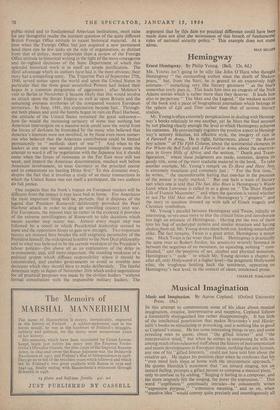Hemingway
Ernest Hemingway. By Philip Young. (Bell. 12s. 6d.) MR. YOUNG isn't going to be silly like John O'Hara who thought Hemingway " the outstanding author since the death of Shakes- peare," but, from the 'Start, he is geared to an excessively high estimate—" something very like literary greatness " as the blurb somewhat coyly puts it. This leads him into an exegesis of the Nick Adams stories which is rather more than they deserve. It leads hint also to perpetrate " The Man and the Legend," the weakest section of the book and a piece of biographical journalism which belongs in the sphere of Life and Time rather than that of serious literary studies.
Mr. Young is often extremely perspicacious in dealing with Heming- way's books relatively to one another, yet he blurs the final account by not placing clearly enough the level at which Hemingway achieves his successes. He convincingly registers the positive aspect in Heming- way's sensory felicities, his effective style, the imagery of rain in A Farewell to Arms. He is right, furthermore, about " the Rover boy action " of The Fifth Column, about the Sentimental elements in For Whom the Bell Tolls and A Farewell to Arms, about the assertive- ness in Green Hills of Africa, and the section, " Death and Trans- figuration," where these judgments are made, contains, despite its gaudy title, some of the most readable material in the book. To take another example, Mr. Young's remark on To Have and Have Not, is extremely trenchant and extremely just : " For the first time," he writes, " the uncomfortable feeling that one•has in the presence of the poseur is really marked." But one feels a want of literary tact when one is told that The Sun Also Rises is Hemingway's Waste Land, when Lawrence is called in as a gloss on " The Short Happy Life of Francis Macomber," and when the question is raised whether or not The Old Man and the Sea is Hemingway's "greatest" and the story in question dressed up with talk of Greek tragedy and Christian symbolism.
Mr. Young's parallel between Hemingway and Twain, initially so interesting, serves once more to blur the critical focus and corroborate too high an estimate of Hemingway. Having• put the two of them into his bag of archetypal pattern and similar structure and having shakenjhem up, Mr. Young draws them bOth out, looking remarkably alike. The fact remains, Twain is a great artist, Hemingway a minor one. Mark Twain is far wiser than Huck. Hemingway is practically the same man as Robert Jordan, his sensitivity severely hemmed in between the negatives of no messiness, no squealing, nothing " com- plicated," and the positives of sex, alcohol and physical sensation. Hemingway's " code " to which Mr. Young devotes a chapter is, after all, only Hollywood at a higher level—the pragmatic Hollywood ethic, the toughness holding back the sentiment, appearing on Hemingway's best level, in the context of clean, condensed prose.
CHARLES TOMLINSON


































 Previous page
Previous page